
Why Does the Tomb of Qin Shi Huang Remain Sealed?
The Tomb of Qin Shi Huang, the first emperor of China, stands as a silent sentinel of a bygone era, its secrets locked away for millennia. While the terracotta army, a mere glimpse into the tomb's grandeur, has captivated the world, the main burial chamber remains untouched. The question lingers: why the reluctance to unveil this historical treasure trove?
Reluctance to Open the Mystery Tomb
The hesitation to excavate the tomb stems from a deep sense of responsibility towards preserving this invaluable piece of history. The potential risks associated with disturbing the site far outweigh the allure of immediate discovery.
Protecting the Fragile Past
- Technological Limitations: Current archaeological techniques, while advanced, are inherently invasive. Excavation carries the risk of irreversible damage to the tomb's structure and its contents. The delicate balance of the underground environment, undisturbed for centuries, could be disrupted, leading to the rapid deterioration of artifacts.
- Unpredictable Dangers: Historical accounts mention the tomb being booby-trapped with rigged crossbows and rivers of mercury. While these claims are difficult to verify without excavation, their presence poses a significant threat to archaeologists and the site itself.
Respecting Ancient Beliefs
- Spiritual Significance: In Chinese culture, disturbing the final resting place of the deceased is seen as disrespectful. The tomb is not just an archaeological site; it holds spiritual significance as the emperor's passage to the afterlife.
- Ethical Considerations: There's an ongoing debate about the ethics of excavating tombs, especially those of such historical importance. Many believe it's crucial to respect the past and leave such sites undisturbed as a testament to bygone eras.
The Future of Exploration
While the tomb remains sealed for now, advancements in non-invasive archaeological techniques, such as ground-penetrating radar and remote sensing, offer a glimmer of hope. These methods allow researchers to peer beneath the surface without physically disturbing the site, gradually piecing together the tomb's layout and contents.
The decision to excavate the Tomb of Qin Shi Huang is a complex one, fraught with ethical, scientific, and cultural considerations. Until there's absolute certainty that the site can be explored without causing harm, the mysteries of the first emperor's tomb will continue to captivate and intrigue us from beneath the earth.
FAQs
Q: What is the significance of the terracotta army if the tomb is still sealed?
A: The terracotta army, located outside the main tomb mound, serves as a testament to the emperor's power and the grandeur of his burial. It offers a glimpse into the artistry and scale of the era, fueling further curiosity about the treasures that might lie within the unopened tomb.
Q: When will the tomb be excavated?
A: There is no set timeline for the excavation of the tomb. The Chinese government has adopted a cautious approach, prioritizing preservation over immediate exploration. The decision to excavate will likely depend on future technological advancements that guarantee minimal risk to the site.
Q: What do experts hope to find inside the tomb?
A: Historical accounts mention vast treasures, intricate maps, and invaluable artifacts buried alongside the emperor. These could shed light on the Qin Dynasty, its culture, technologies, and the emperor's reign, potentially rewriting history as we know it.
note: This return of all, without the author's permission, may not be reproduced